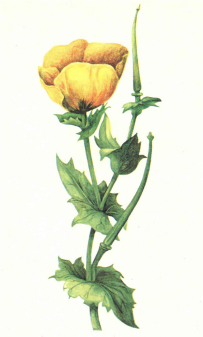A biennial plant with bluish basal and stem leaves that are lyrate-pinnatisected. The flowers are large and yellow. It has numerous stamens, and the fruit is a very long (up to 25 cm) pod-like capsule. A distinctive characteristic of this genus compared to others is the presence of a septum in the fruit (in Chelidonium, Roemeria, and Hylomecon, the fruit is also pod-like but lacks a septum). The entire plant exudes a yellow milky sap. It blooms in May and June. It grows along the Black Sea coast in Crimea and the Caucasus, with plantations established in the Krasnodar region.

The herb contains 12 alkaloids, the primary one being glaucine, a derivative of isoquinoline. The total alkaloid content in the herb ranges from 2.94% to 3.95%, depending on the growth stage, with glaucine constituting 1.56% to 2%. The roots predominantly contain protopine, a characteristic alkaloid of the family. Approved for use is glaucine hydrochloride, produced in 0.05 g tablets; it is taken orally at a dose of one tablet 2–3 times a day after meals as a non-narcotic antitussive agent.
Three other species have been studied in Central Asia. All of them contain alkaloids similar to opium alkaloids and those of celandine, such as protopine and others. Glaucine has been found in the annual Glaucium corniculatum (L.) Curt, along with protopine and allorhytopine.
